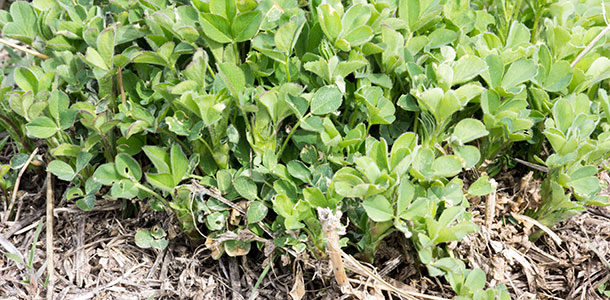Alfalfa also has experienced some pretty tough weather conditions the past couple of winters and growing seasons in many regions. Some alfalfa plants that managed to survive the harsh weather are showing the accumulated effects of all that stress.
Add the stress from harvest plus any insect damage, leaf diseases and crown or root rots, and plants that were old or weak starting out this spring may simply have too little healthy root to keep going. Not only that, but most dryland fields have removed all the subsoil moisture that young alfalfa stands use to support extra yield.
Now is a good time to check fields to learn if they need to be replaced, either with a new seeding this August or next spring. If weeds are becoming a problem, that suggests replacement. Also evaluate your stands.
Research suggests that alfalfa needs to produce 55 or more shoots per square foot to maximize yield. Yield potential tends to decline about one-tenth of a ton per acre for each shoot number below 55 per square foot.
In semi-arid regions, older, dryland fields with less than 25 to 30 shoots per square foot coming from two or three plants should be replaced. More productive sites, such as in semi-humid regions or irrigated and sub-irrigated fields, should have over 40 shoots per square foot from four to six plants.
Also dig up and look at some roots. Healthy roots are solid and white, with a firm texture. A little browning in the top couple inches of the crown may not be much of a problem yet, but it could develop into a serious disease in another year or two.
Roots that are discolored in a third to one-half of the tissue might survive this coming winter, but plants will not yield well next year. If crowns and taproots show extensive brownish discoloration or are becoming mushy and partly rotted, these plants probably won’t survive another winter.
Adding grass to thin alfalfa
Some thin alfalfa stands with healthy roots on remaining plants can be rejuvenated by interseeding grasses and converting them to pasture or haying a grass-alfalfa mixture. Not only might you extend the useful life of your alfalfa field by several years, you also will develop excellent hay or grazing for your livestock.
Orchardgrass is the grass most commonly interseeded into alfalfa, but other cool-season grasses like endophyte-free tall fescue, meadow brome, festulolium, perennial ryegrass and wheatgrasses also can be used. In fact, if the field will be used as pasture, a mixture of several grasses may be best since it adds diversity to your animal’s diet.
Interseeding after a mid-August to early September hay harvest can be excellent timing if you have moisture to start the new seedlings. Alfalfa regrows more slowly this time of year, so it won’t compete as aggressively with your new grass seedlings.
Still, if your alfalfa is relatively thick, you may need to take another cutting in about four weeks or as soon as the alfalfa starts to form a full canopy. This allows sunlight to continue to reach new seedlings below the alfalfa.
Next spring you will need to judge how well established your new grasses have become. If they seem a little weak, cut hay early to again open the canopy for better light penetration. After that you should be able to hay or rotationally graze as you choose.
Interseeding grass into existing alfalfa takes timely haying and planting, but both land and livestock will improve with your efforts. Replace them on your terms instead of Mother Nature’s. FG
Bruce Anderson is an extension forage specialist with the University of Nebraska – Lincoln.










